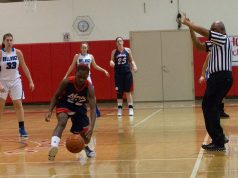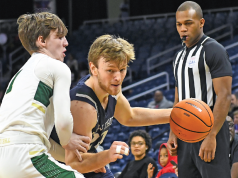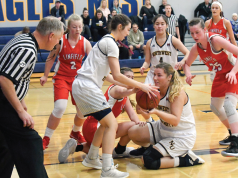Basketball officials have been instructed time and again about the importance of pregame discussions as a crew. The 60 minutes prior to tip are a crucial window for an exchange of information between the two or three members of a crew to put everyone in the best position possible to work that night’s game and to make sure the crew is on the same page and communicating effectively with one another.
We also know the best crews are the ones that realize their work isn’t done when the final horn sounds and they walk off the floor. Postgame de-briefings are extremely important, as they allow us to reflect on what just happened, discuss any noteworthy plays or rulings, and glean insights that can help us become better officials moving forward.
However, I would posit that on a night-in, night-out basis, the one necessary period of banter that we sometimes short-change, and the one we absolutely shouldn’t given the possible implications of doing so, is the halftime discussion between the crew.
Think about it. A pregame addresses what we expect to happen. A postgame addresses what already happened. A halftime discussion addresses what is happening.
It’s an opportunity to share realtime information and combine the best of both worlds of a pregame and a postgame. We now have one half’s worth of relevant information to draw upon for our next 16 minutes (NFHS) or 20 minutes (NCAA) of work. We aren’t discussing plays and situations and thinking about how to better officiate them two days from now when we next step back out on the floor. We should be using that knowledge to become better officials in the next 10 minutes.
Often I have worked on crews that view halftime as nothing more than break time. Use the toilet, drink some Gatorade, get off one’s feet for a couple minutes in the changing room and then back at it. Officiating crews that use halftime in that manner are wasting a valuable opportunity to prepare for the second half. And as most of us have said at one point or another in our officiating careers, anyone can officiate a first half. The second half is when we earn our paychecks.
So what should you be doing at halftime, in addition to the aforementioned personal business?
Discuss the first half
Just as both teams are in their respective locker rooms discussing what worked and what didn’t from their perspectives before halftime, the officiating crew should be doing the same thing. How is crew communication? How is the crew’s consistency? Is every member of the crew calling the same game? Are you comfortable with the game you have been calling? Are there any plays or rulings that need immediate attention?
Share what you know
With one half in the books, your Spidey sense should be tingling about bits of information to share with your partners. Have you identified the “game wreckers” for each team? Has there been some type of discussion or interaction that makes you aware that a particular coach is going to be problematic going forward? Have you had to issue a subtle warning to players in the low post about clearing the lane or too much off-ball contact? Share those observations with your partners so that no one is caught by surprise in the second half and the entire crew can fine-tune its collective radar.
Talk about adjustments
Good teams are those that can take what just transpired, learn from it and make immediate adjustments in the second half. This is true for the coaches and players, and it’s likewise true for the officials. Is one team shooting a lot of threepointers, necessitating the need for the perimeter officials to do a better job of locking in on airborne shooters? Is one team playing a fullcourt, trapping defense that will require a more engaged “C” official in the backcourt? Does the crew need to rotate more or less? Use what happened in the first half to put your crew in the best position to succeed in the second half.
Call the same game
While second-half adjustments are important, second-half overhauls are a recipe for disaster. Officials hear all the time that all coaches and players really want is consistency. They now have a full half’s worth of information about how your crew is working the contest. Now is not the time to completely change course on them. If your crew came out with a tight whistle in the first half, it should be the same after the break. Adjusting means putting yourself in the best position to work the game, not making drastic philosophical shifts in how often you put air in the whistle. Call the same game and make the players adjust — it should not be the other way around.
The dreaded “O” word
The reality is, you will be working free basketball at some point in your officiating career. The basketball gods will make sure of it. And when that happens, you need to be prepared to do so in proper fashion. Halftime is when your crew needs to have the discussion about how to proceed if the game goes into overtime. This isn’t hockey. You don’t get a second intermission. Instead, the final horn sounds, everyone re-calibrates after the exuberance of a hard-fought game that remains tied, and now you must elevate your game for the most crucial four or five minutes of the contest. Use halftime to discuss the key OT parameters. How long is it? Do the timeouts carry over? How many stoppages are now allowed? How is the bonus rule administered? And, should the unfortunate arise, how are technical fouls handled if they occur between the final buzzer and the start of overtime play?
If halftime sounds like a busy 10 minutes, that’s because it is. Sure, enjoy the physical break and nourishment that will allow you to be at your best for the second half. But remember mentally, your work is just beginning. Take one minute to collect your thoughts, re-engage and show your partners there is a very good reason why they want to share the floor with you during the second half.
Scott Tittrington is an associate editor at Referee. He officiates high school and college basketball, umpires high school and college baseball, and officiates high school football.
What's Your Call? Leave a Comment:
Note: This article is archival in nature. Rules, interpretations, mechanics, philosophies and other information may or may not be correct for the current year.
This article is the copyright of ©Referee Enterprises, Inc., and may not be republished in whole or in part online, in print or in any capacity without expressed written permission from Referee. The article is made available for educational use by individuals.


















